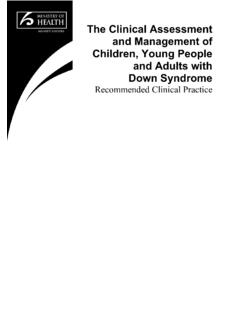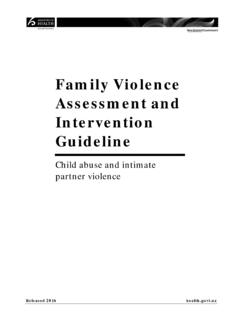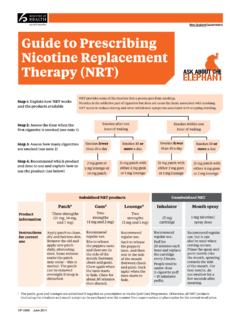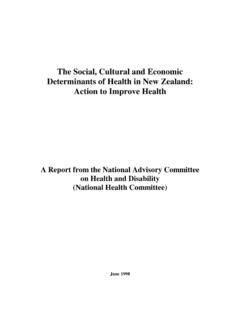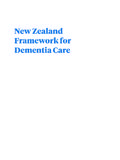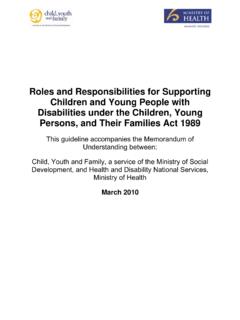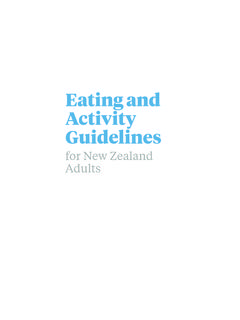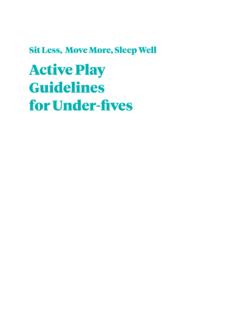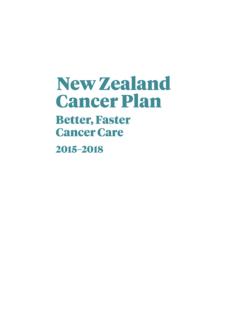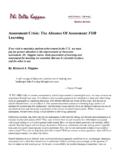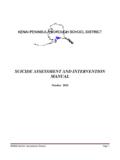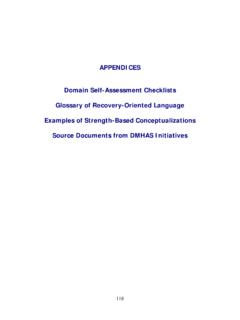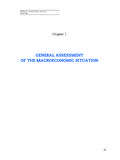Transcription of THE ASSESSMENT AND MANAGEMENT OF …
1 THE ASSESSMENT ANDMANAGEMENT OFPEOPLE AT RISKOF SUICIDEBEST PRACTICEEVIDENCE-BASEDGUIDELINEMAY 2003 EndorsementsThe Royal Australian and New Zealand College of Psychiatrists - New Zealand Mental Health Nurses SectionCouncil for Mental Well-Being TrustBest Practice Evidence-basedGuidelineTHE ASSESSMENT AND MANAGEMENT OF people AT RISK OF SUICIDEFor Emergency Departments and Mental Health Service Acute ASSESSMENT SettingsMAY 2003 2003 New Zealand Guidelines Group (NZGG) and Ministry of HealthPO Box 10 665, The Terrace,Wellington, New ZealandPhone: 64-4-471 4180 Facsimile: 64-4-471 4185E-mail: - click on Guidelines then Mental Health Published: May 2003 Review Date: 2008 ISBN: 0-473-09302-2 STATEMENT OF INTENTC linical guidelines are produced to help health professionals and consumers make decisions about health care in specific clinical circumstances.
2 Research has shown that if properly developed, communicated and implemented, guidelines can improve care. The advice on the ASSESSMENT and MANAGEMENT of people at risk of suicide given in this guideline is based on epidemiological and other research evidence, supplemented where necessary by the consensus opinion of the expert development team based on their own experience. While the guidelines represent a statement of best practice based on the latest available evidence (at the time of publishing), they are not intended to replace the health professional s judgment in each individual case. CONTENTSF oreword iAbout the Guideline iiiSummary ixCHAPTERS1 Background Issues 1 Epidemiology 1 Risk Factors 32 ASSESSMENT of Suicidality by Emergency Departments 11 Triage 11 General ASSESSMENT Principles 13 Medical Clearance 13 Sedation 14 ASSESSMENT of Intoxicated people 15 Referral to Mental Health Services 163 Detailed Suicide ASSESSMENT / ASSESSMENT by Mental Health Services 19 Mental State Examination 20 Information from Wh nau/Family/Friends 20 Physical Illness 20 Key Components of a Psychiatric/Psychosocial ASSESSMENT 20 Use of Screening Measures 21 Formulating Risk 214 Crisis/Initial MANAGEMENT 25 MANAGEMENT as an
3 Outpatient 25 The Decision to Hospitalise 26 MANAGEMENT as an Inpatient 27 Discharge Planning 27 Intervention/Treatment Strategies 28 Prescribing Issues 2955 ASSESSMENT and Crisis MANAGEMENT with Special Populations 31 Children and Adolescents 31 The Elderly 32M ori 33 Pacifi c Peoples 34 people of Indian Descent 36 Asian Populations 37 Refugee Groups 38 ASSESSMENT and MANAGEMENT of Chronically Suicidal people 396 Implementation 41 Gaps and Barriers to Implementation 41 Key Implementation Issues 427 Auditing the Guidelines 45 APPENDICES 471. Rapid ASSESSMENT of Patients in Distress 482. ASSESSMENT of Risk of Suicide 503. The Mental State Examination 534.
4 Comprehensive Psychiatric/Psychosocial ASSESSMENT 555. Guidelines for Providing a Safe Home for a Suicidal Person 596. Levels of Observation in Inpatient Units 617. Risk Factors for Suicide 628. Evidence and Recommendation Grading System Used for this Guideline 63 Glossary 65 References 69 FOREWORDS uicide is a devastating event for those close to the person who died, with enduring emotional consequences. It also affects the wider community, both emotionally and economically. It is generally, although not always, associated with mental illness. Effective treatment of the mental illness can reduce or abolish the risk of suicide.
5 Effective treatment requires effective recognition and a reduction in the barriers to appropriate care. These barriers include stigma against mental illness and limited public knowledge about symptoms indicating mental illness. They also include diffi culties accessing affordable available services, adequately staffed by suitably trained clinicians. Such services need to interface effectively with other relevant organisations and people to provide a full range of appropriate interventions. These need to be continued for long enough to reduce suicide risk and improve mental health in the long-term. It is clear from recent reportssuch as the Mental Health Commission Review of Crisis Mental Health Services1 that this ideal is not currently achieved in New guidelines are intended as a resource for clinical staff in emergency departments and mental health clinicians when assessing and working with people who have made a suicide attempt, or are at risk of taking their own lives.
6 They are intended as a teaching resource and as a guide to daily practice, both for individuals and for systems of care. They are based on explicit evidence where possible and synthesised expert opinion on other issues. They are complemented by summary material for each service a guideline is, in many ways, the easy part of the task of improving practice. Achieving commitment to changes in practice and changes in systems of care requires effective implementation. This must be backed by quality educational measures, which are maintained over time and supported by adequate supervision on a regular basis, clinical audit, and quality improvement processes.
7 These strategies require appropriate piloting, evaluation, and adequate resources if the promise of this document is to be achieved. The Ministry of Health is committed to reducing the rate of suicide and suicide attempts. We urge them to ensure that these guidelines are implemented by District Health Boards to achieve these Pete EllisChair, Guideline Development Teamiii ABOUT THE GUIDELINES uicidal behaviour is one of the most common and stressful of psychiatric [3] There is no single explanation for suicide attempts nor any simple solutions to ,4[1+] Survivors of suicide attempts indicate that the central reason for their suicide attempt was not death but rather the stopping of consciousness, or pain that was perceived as [3]
8 Overseas, a large proportion of people who arrive at accident and emergency departments following an attempted suicide are discharged without follow-up and without having been formally assessed for psychiatric illness or psychosocial stressors, some even before they have been medically cleared .6[2-] Typically these people are young, male, intoxicated, have diffi culty coping with strong feelings and have a history of previous attempts. Given these risk factors, it is not surprising that they more frequently go on to make further attempts at [2-] This has particular implications for accident and emergency staff, who need to be able to carry out an initial psychosocial risk ASSESSMENT , provide an environment that can contain such at risk people until they can be assessed in more detail, and access psychiatric assistance purpose of these guidelines is to guide those working in emergency departments and in acute psychiatric services in the appropriate ASSESSMENT and early MANAGEMENT of suicidal people .
9 They complement the related primary mental health guidelines for use in general practice,8 schools,9 and also the Guidelines for Clinical Risk ASSESSMENT and MANAGEMENT in Mental Health Services (1998).10 They replace the earlier guideline for mental health services prepared by the Ministry of Health in guidelines focus on intervening with people who have made a suicide attempt with the intent (or partial intent) of ending their lives and those who are at risk of taking their own life. Some people harm themselves deliberately without suicidal intent, such as by repeated cutting or other forms of deliberate self-harm. While some of the MANAGEMENT principles described in these guidelines may be helpful for assisting these people , additional measures are necessary, which are beyond the scope of these guidelines.
10 The Royal Australian and New Zealand College of Psychiatrists is currently developing guidelines for the treatment of adult deliberate self-harm which are due for release in guidelines are evidence-based. Where clear recommendations for action are made, there are statements about the strength of supporting evidence that these are built upon. In the absence of research evidence, recommendations are made on the basis of the expert opinion of a working party of nominated individuals, substantiated by a wide peer review is acknowledged that the low base rates of suicide make it diffi cult to predict such a tragedy and that despite best efforts some people will nevertheless complete suicide.
